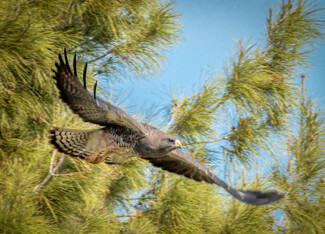More Hawks Than Ever
Last updated 5/24/2023 at 12:19pm
Borrego Hawkwatch 2023 is officially completed, but the count of migrating Swainson's hawks continues because of the unprecedented numbers of birds stopping in Borrego Springs on their journey north of South America.
Officially the annual count begins March 1 and continues through April 15. This year, the migrating hawks began arriving early and the count began on Feb. 26.
Local bird experts credit the timing and the amount of winter rains for creating habitat conditions that provided a feast for migrating birds.
These ideal conditions brought the official count total to 16,000 Swainson's, along with 540 turkey vultures. This was a record in the 21 years the annual census has been conducted.
The previous record was the wet year of 2017 when 11,690 hawks were recorded. In the Drought year of 2019, only 1,086 hawks were observed.
But, as they say, there's more to the story.
Typically, hawk numbers dwindle by April 15, or they vanish completely, but the thieving population of grasshoppers because of winter rains has provided an abundant food source.
Migrating hawks got the message and they have eagerly taken advantage of the available food, with huge numbers continuing beyond the April 15 official census period.
"This season is the most remarkable migration in 21 years," said Hal Cohen, Hawkwatch coordinator. "It's all about grasshoppers. The Swainson's Hawks are called Grasshopper Hawks and if you walk into any of the old agriculture fields around town, you will be assaulted by grasshoppers, some 2.5 inches long."
Since the migration seems to continue unabated, Cohen and his dedicated band of volunteers will continue the daily census.
You can also be added to an ALERT email list that notifies birders when more than 100 hawks are seen entering the valley in the evening. To be added to the ALERT, send a request to Cohen at Raptorhal3@gmail.com.
This has been a busy year for ALERTS with nearly 20 having sent out and counting.
By press time, more than 14,000 hawks had been recorded with some days as many as 500 flying in to feed and roost for the night.
Borrego Hawkwatch is a unique citizen science event that has volunteers in the field daily during the count to monitor both arriving and departing birds.
Cohen, a retired college biology professor, launched the count after noticing the Borrego Springs appeared to be on the migration route of the beautiful hawks that travel from South America to the northern parts of North America each spring.
Volunteer hawk watchers are in the field at 8 a.m. each day at the official county site, located on DiGiorgio Road, 2.8 miles north of Palm Canyon Drive. Each evening starting an hour before sunset, counters meet on Borrego Valley Road, 1.8 miles north of Palm Canyon Drive, to observe birds coming into roost for the night.
It's an impressive sight to witness the morning launch of migrating birds.
Sometimes as many as 700 or more birds will begin to rise from the desert and circle in a formation known as a kettle. Some call it a bird tornado.
They continue to circle and climb until capturing wind currents that will assist them in moving northward.
Additional information about the count, along with photos can be found at Borregohawkwatch.blogspot.com. Information on other North American watches is available at Hawkcount.org.












